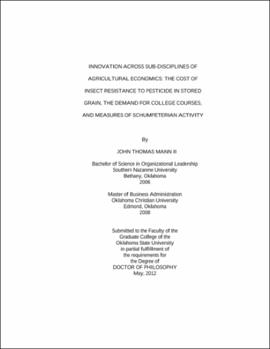| dc.contributor.advisor | Adam, Brian Dale | |
| dc.contributor.author | Mann, John Thomas II | |
| dc.date.accessioned | 2013-11-26T08:22:02Z | |
| dc.date.available | 2013-11-26T08:22:02Z | |
| dc.date.issued | 2012-05 | |
| dc.identifier.uri | https://hdl.handle.net/11244/6524 | |
| dc.description.abstract | Scope and Method of Study: | |
| dc.description.abstract | This work is composed of four individual articles. The first uses mathematical programming and recent discoveries in entomology genetics to determine the cost of insect resistance to phosphine fumigants in stored grain. The second uses a conditional logit model based on a choice experience to determine students' preferences for online and face-to-face college courses and course attributes. The third uses an ordered logit model based on survey responses to identify the characteristics of students selecting online courses. The fourth uses principle component analysis to develop composite entrepreneurship indicator as a measure of Schumpeterian activity for states. | |
| dc.description.abstract | Findings and Conclusions: | |
| dc.description.abstract | The major findings of each article are as follows. 1) Costs associated with fumigant-resistant insects make integrated pest management more attractive than calendar-based fumigation in cooler climates. There may also be an externality due to higher fumigation effectiveness. Since high proportions of strong resistant pests only begin to appear after a long time-horizon when fumigation effectiveness is high, managers may be unaware of pest resistance levels until strong resistant insects are in high proportions. 2) Student's preferences for online or face-to-face (F2F) courses depend on specific attributes of the courses. Students reported having the highest preferences for customized online courses. Additionally, the frequency with which students selected online courses increased as more online course information was available. 3) Based on survey responses, half of college-age undergraduate students reported taking at least one online course. Freshman and sophomores were more likely to select online courses than juniors and seniors. Additionally, there are indications that use of web 2.0 technologies was positively related to the likelihood of students selecting online courses. 4) The composite entrepreneurship indicator (CEI) was negatively correlated with firm births, sole-proprietorships, and the Kauffman Index of Entrepreneurial Activity, and was positively correlated with average wage per job data. This suggests that states with higher levels of firm births have lower levels of Schumpeterian activity. These results also suggest that firm births are not good measures of Schumpeterian-type entrepreneurship. | |
| dc.format | application/pdf | |
| dc.language | en_US | |
| dc.rights | Copyright is held by the author who has granted the Oklahoma State University Library the non-exclusive right to share this material in its institutional repository. Contact Digital Library Services at lib-dls@okstate.edu or 405-744-9161 for the permission policy on the use, reproduction or distribution of this material. | |
| dc.title | Innovation across sub-disciplines of agricultural economics: The cost of insect resistance to pesticide in stored grain, the demand for college courses, and measures of Schumpeterian activity | |
| dc.contributor.committeeMember | Rastegari-Henneberry, Shida | |
| dc.contributor.committeeMember | Shideler, David W. | |
| dc.contributor.committeeMember | Goad, Carla Lynn | |
| osu.filename | Mann_okstate_0664D_12126.pdf | |
| osu.accesstype | Open Access | |
| dc.type.genre | Dissertation | |
| dc.type.material | Text | |
| dc.subject.keywords | online learning | |
| dc.subject.keywords | pest resistance | |
| dc.subject.keywords | schumpeterian activity | |
| thesis.degree.discipline | Agricultural Economics | |
| thesis.degree.grantor | Oklahoma State University | |
